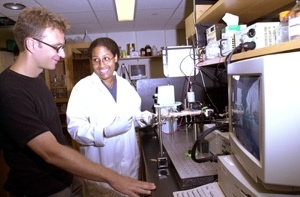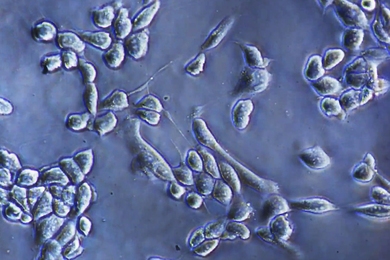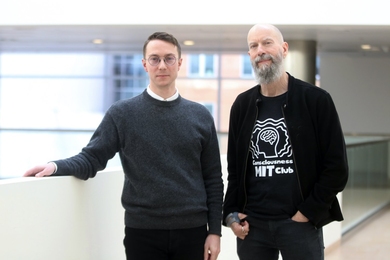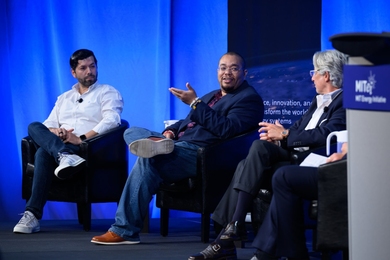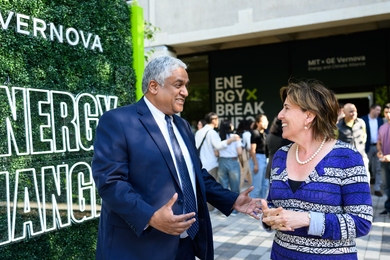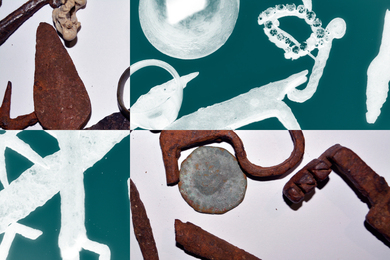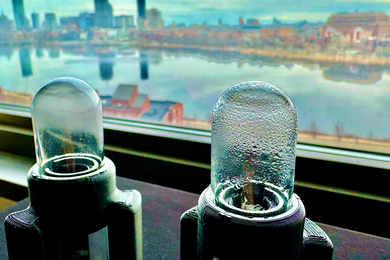This story originally ran in Two if by Sea, the joint newsletter of the MIT and Woods Hole Sea Grant programs, Vol. 5., No. 1.
How tedious is Martin Polz's research with harmful microorganisms? "Not only are we looking for needles in a haystack, but we want to quantify the needles in the haystack, too," said Polz, an assistant professor in the Department of Civil and Environmental Engineering.
While incidences of marine-related illnesses and harmful algal blooms are increasing, the explanation for such rises is unclear. This is at least partly due to the difficulty of quantifying critical changes in small populations of microorganisms in the marine environment. Although there are programs to monitor a variety of pathogens, there's little understanding of the onset, duration and general causes of conditions that allow the growth of microorganisms that cause illness in marine life and/or humans.
To help remedy this, Polz and colleagues are studying the complete life cycles of harmful marine microorganisms, or microbial pathogens. The research, which involves development of new molecular techniques that detect and quantify small microbial populations, is funded by MIT Sea Grant through a two-year Doherty Professorship.
Polz's collaborators in the project include Ee Lin Lim, an assistant professor at Temple University who was previously a postdoctoral associate in the department; Luisa Marcellino, a current postdoc; and Janelle Thompson, a Ph.D. student in the MIT/Woods Hole Oceanographic Institute joint program.
In the past, researchers studying such pathogens would isolate an organism responsible for an infection and then attempt a re-infection to see if the same pathological response occurred. However, Polz said, "we've learned that for many diseases, identification of the responsible microorganism is an elusive process because so many microorganisms are difficult to culture. Thus, we really need to learn to correlate the abundance of certain microorganisms with certain disease symptoms."
Polz likened studying these patterns to learning from nature when there might be a problem. Because scientists don't know how to culture most microorganisms in nature, he decided to examine the microorganisms' genes. This means looking for genetic markers, or fingerprints, in the environment, and identifying them through gene sequences much the way police take DNA samples to help solve a crime.
"Once we have that marker," he explained, "we can then go back into the environment and use fairly sophisticated new molecular biology techniques that allow us to detect and count how many of that marker gene X we have in a particular environment sample. That number can tell us, 'Well, we have 10 copies of that particular gene in our particular environmental sample.'" Because an organism's genome doesn't change that rapidly, the numbers of copies for a genome can then be correlated to cell numbers.
Polz and his colleagues are concentrating on a group of organisms called vibrios, which are common marine bacteria that contain a large number of completely harmless organisms but also a number of vicious pathogens such as Vibrio cholera and Vibrio vulnificus. The latter is responsible for more than 95 percent of seafood-related food poisoning deaths in the United States and also causes severe but hard-to-detect infections in oyster farms.
Another type of bacteria, Vibrio anguillarum, presents a huge problem in aquaculture, often killing fish within hours of infection. "Once you get the bacteria there's almost nothing you can do," Polz said--hence the need for warning signs.
To quantify these potentially dangerous microorganisms, Polz is using two powerful molecular biology techniques: the polymerase chain reaction (PCR) and constant denaturant capillary electrophoresis (CDCE). This combination was first introduced by Professor William Thilly, director of MIT's Center for Environmental Health Sciences, to identify mutations in humans resulting from smoking and other environmental influences.
Using the techniques for pathogen detection, Polz has identified a gene sequence which uniquely identifies all species of vibrios. Thus, if vibrios are present in an environmental sample, the PCR can be used to amplify this gene, producing a DNA fragment of a concentration several million times greater than the DNA of non-vibrio species in the sample. Identifying which vibrio species (pathogenic or harmless) are actually present in the sample is then done by the CDCE.
With this machine--roughly the size of a bread box--amplified genes are loaded into a very fine capillary, which separates the genes out according to sequence, allowing resolution to a single-nucleotide difference. Whenever a sequence passes past a laser, which is focused on the capillary with a microscope lens, a fluorescent molecule previously attached to the DNA gets excited and emits light. The signal is then uploaded onto a computer and can be used to quantify how much of a particular sequence, which is diagnostic for a certain vibrio species, was present in the sample. Ultimately, the PCR-CDCE machine allows simultaneous quantification of multiple vibrio species in environmental samples.
While developing the techniques is an ongoing and lengthy process, Polz said that once established, they will be quite fast. And while the apparatus is fairly sophisticated, it does not need to be on location. For instance, he imagines a field trip to India to collect water samples where cholera is rampant. Those samples could be frozen and transported back to the lab for analysis.
To emphasize the needle-in-a-haystack quality of their work, Polz pointed out that a milliliter of seawater (a thousandth of a liter) can contain more than a million individual bacteria cells. "And we may be looking for 10 cells of one particular species amongst this million. It's really not an easy task," he said.
That's why he and his colleagues are proud that they've been able to quantify about five cells per milliliter of Boston Harbor water. "That's the lowest detection anyone has done of real dirty seawater full of gunk that could potentially interfere with detection," he said. "We're moving in the right direction."
Figuring out what causes diseases is still a few years away and will require monitoring efforts over the course of seasonal cycles to study bacterial pathogens while they are also dormant. Polz said good progress is being made now with toxic algae, which are bigger, easier to recognize and can be seen under a microscope.
Polz has been surprised thus far at the number of different vibrios they've found. "Because those bacteria have a tendency to interact with animals, particularly with fish, we think we'll find some very interesting interactions," he predicted.
Upcoming field work will look at the population dynamics of Vibrio vulnificus in New England oyster beds but may ultimately be expanded to the development of molecular techniques to monitor other harmful organisms in the environment, such as the brown tide alga Aureococcus anophagefferens that has severely affected New England waters in recent years.
All these efforts should help researchers better understand the causes of disease outbreak and lead to strategies to help protect both human health and marine life from hazardous marine bacteria and algal blooms.
A version of this article appeared in MIT Tech Talk on September 26, 2001.
